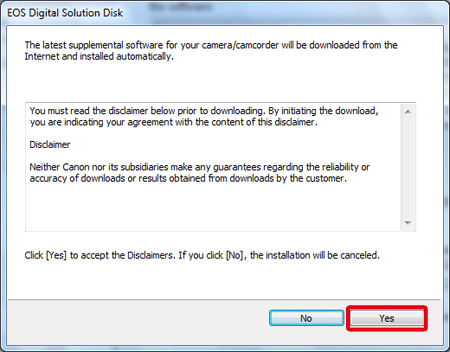Solusi
Preparing to import images to the computer (software installation)
You can use the any of the software on the "EOS DIGITAL Solution Disk (CD-ROM)" that came with your camera to import images you have taken to your computer.
See the related information for characteristics of each software.
IMPORTANT
- Never connect the camera to your computer before you install the software. The software will not be installed correctly. Also, make sure to check the software system requirements against the specifications of your computer.
- Install ImageBrowser EX from the CD that came with your camera even if ImageBrowser EX is installed already on the computer you are using. You can update to the optimal version that supports the features of the camera you are using. You can also add new features using the Auto Update feature.
- Use the procedure below to install software other than ImageBrowser EX as well when an older version is installed (the installation will overwrite the previous installation).
1. Turn your computer on.
2. Insert the EOS DIGITAL Solution Disk (CD-ROM) into the computer.
If the following window appears, click [Run SETUP.EXE].
If you are using a Macintosh computer, double-click the CD-ROM icon on the desktop, and then double-click [Canon EOS Digital Installer].
3. Select the area in which you live.
4. Select the country where you live, and then click [Next].
5. Click [Easy Installation] (to install all applications included on the Solution Disk).
For a Macintosh computer, click [Install].
NOTE
6. Close any other applications, and then click [OK].
8. Click [Yes] to accept the License Agreement.
9. With EOS DIGITAL Solution Disk Ver. 25 or later, when connected to the Internet, the following screen will appear. If you agree to the disclaimers, click [Yes].
10. The following window appears, and installation starts.
11. When the following window appears, click [Install now]. Proceed with the installation by following the on-screen instructions for the required operations.
12. When the following window appears, click [Yes].
14. The following window appears. Select [No, I will register later.] here, and then click [Next].
To register your camera on CANON iMAGE GATEWAY, select [Yes, I would.].
15. Remove the CD once the computer restarts.
NOTE
Check the following if the software cannot be installed.
Connect the camera and the computer
1. Confirm that the camera is not connected to the computer, and then set the camera's power to <ON>.
2. Press the <MENU> button to display the menu.
3. Change the camera's Auto power off settings.
3-1. Under the [

] tab, select [Auto power off], then press <

>.
3-2. Select [Disable], then press <

>.
4. Press the <MENU> button to turn off the display on the LCD monitor, and then turn the camera's power to <OFF>.
5. Plug the supplied interface cable into the USB port on your computer.
Please refer to the documentation provided with your computer for more information.
6. Connect the cable to the camera’s <DIGITAL> terminal with the cable plug’s <

> icon facing the front of the camera.
NOTE
If no connection is recognized between the camera and computer even when they are connected as described in the procedure, confirm the following.
Download images to the computer
1. Set the camera's power switch to <ON>.
2. Communication between the camera and the computer begins.
Click [

] in the task bar to display the following screen.
Click [EOS Utility] to start EOS Utility.
When the camera and computer become capable of communicating, EOS Utility will start.
3. The main window for EOS Utility appears.
To download all images saved in the memory card, click [Starts to download images] in the EOS Utility window.
By default, the downloaded images are sorted into folders by their shooting date, and are saved in the [Pictures] folder on the computer. If you wish to change the destination for the downloaded images, click [Preferences] and specify the settings in the dialog box.
NOTE
4. The images are downloaded to the computer.
5. When all the images have been downloaded, Digital Photo Professional starts and the downloaded images are displayed.
When downloading images, you can change the associated software from Digital Photo Professional to ImageBrowser EX. Click [Preferences] on the main screen of EOS Utility to set the association on the dialog box that is displayed.
Confirming the images downloaded to the computer
Images downloaded to your computer are displayed as a thumbnails list in the main window.
By default, folders are created by shooting date. When you select the folder with the shooting date that you want to confirm, a list of the images recorded to this folder is displayed.
IMPORTANT
- Images displayed with the [
 ] icon are movie files and cannot be played back in DPP. Please use "ImageBrowser EX", which is compatible with EOS DIGITAL movie files.
] icon are movie files and cannot be played back in DPP. Please use "ImageBrowser EX", which is compatible with EOS DIGITAL movie files.
- If the message [Insufficient memory.] appears, there are too many images in one folder. Decrease the number of images in one folder such as by dividing them into smaller folders.
You can double-click an image to open the edit window and display the image at large size.

















 ] tab, select [Auto power off], then press <
] tab, select [Auto power off], then press < >.
>.
 >.
>.

 > icon facing the front of the camera.
> icon facing the front of the camera.

 ] in the task bar to display the following screen.
] in the task bar to display the following screen.



 ] icon are movie files and cannot be played back in DPP. Please use "ImageBrowser EX", which is compatible with EOS DIGITAL movie files.
] icon are movie files and cannot be played back in DPP. Please use "ImageBrowser EX", which is compatible with EOS DIGITAL movie files. 